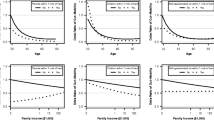Abstract
This study examines length of residence for movers—that subsection of the population which accounts for the high mobility rates in the United States. The propensity for repeated migration is studied in relation to economic opportunities and previous familial and personal contacts. The results indicate no influence of economic opportunities on duration of residence. This finding is consistent with recent research that indicates economic conditions are not a general stimulus for out-migration, although they are for in-migration. On the other hand, length of residence is found to be longer where previous familial and personal contacts existed. Overall, the results provide additional evidence of the importance of social, as opposed to strictly economic, variables in the migration process.
Similar content being viewed by others
References
Bogue, Donald J., H. S. Shryock, Jr., and S. A. Hoermann. 1957. Subregional Migration in the United States, 1935–40: Streams of Migration Between Subregions. Oxford, Ohio: Scripps Foundation, Miami University.
Bowles, Samuel. 1969. Migration as Investment: Empirical Tests of the Human Investment Approach to Geographic Mobility. Discussion Paper No. 51. Cambridge, Mass.: Program on Regional and Urban Economics, Harvard University.
Brown, J. S., H. K. Schwarzweller, and J. J. Mangalam. 1963. Kentucky Mountain Migration and the Stem Family: An American Variation on the Theme by LePlay. Rural Sociology 28:48–69.
Choldin, H. M. 1973. Kinship Networks in the Migration Process. International Migration Review 7:163–175.
Duncan, Otis D., and A. J. Reiss, Jr. 1956. Social Characteristics of Urban and Rural Communities, 1950. New York: John Wiley and Sons.
Galle, O. R., and K. E. Taeuber. 1966. Metropolitan Migration and Intervening Opportunities. American Sociological Review 31:5–13.
Glenn, N. D., A. A. Ross, and J. C. Tully. 1974. Patterns of Intergenerational Mobility of Females Through Marriage. American Sociological Review 39:683–699.
Goldstein, S. 1954. Repeated Migration as a Factor in High Mobility Rates. American Sociological Review 19:536–541.
— 1964. The Extent of Repeated Migration: An Analysis Based on the Danish Population Register. Journal of the American Statistical Association 59:1121–1132.
Goodrich, Carter, B. W. Allin, and M. Hayes. 1935. Migration and Planes of Living, 1920–1934. Philadelphia: University of Pennsylvania Press.
Greenwood, M. J. 1975. Research on Internal Migration in the United States: A Survey. Journal of Economic Literature 13:397–433.
Lansing, John B., and E. Mueller. 1967. The Geographic Mobility of Labor. Ann Arbor: Survey Research Center, Institute for Social Research, University of Michigan.
Lee, E. S. 1966. A Theory of Migration. Demography 3:47–57.
Litwak, E. 1960. Geographic Mobility and Extended Family Cohesion. American Sociological Review 25:385–394.
Lowry, Ira S. 1966. Migration and Metropolitan Growth: Two Analytical Models. San Francisco: Chandler Publishing Company.
McGinnis, R. 1968. A Stochastic Model of Social Mobility. American Sociological Review 33:712–722.
McGinnis, R., and J. E. Pilger. 1963. On a Model for Temporal Analysis. Paper presented to the American Sociological Association, Los Angeles.
Morrison, P. A. 1967. Duration of Residence and Prospective Migration: The Evaluation of a Stochastic Model. Demography 4:553–561.
— 1971. Chronic Movers and the Future Redistribution of Population: A Longitudinal Analysis. Demography 8:171–184.
Myers, G., R. McGinnis, and G. Masnick. 1967. The Duration of Residence Approach to a Dynamic Stochastic Model of Internal Migration: A Test of the Axiom of Cumulative Inertia. Eugenics Quarterly 14: 121–126.
Newman, S. 1974. Desire to Move Is Tied to Housing Rather than Poor Community Services. Newsletter (Winter):7–9. Ann Arbor: Institute for Social Research, University of Michigan.
Organic, H., and S. Goldstein. 1970. The Brown University Laboratory: Its Purpose and Initial Progress. Pp. 212–232 in Irving I. Kessler and M. L. Levin (eds.), The Community as an Epidemiologic Laboratory: A Casebook of Community Studies. Baltimore: The Johns Hopkins Press.
Ravenstein, E. G. 1885. The Laws of Migration. Journal of the Royal Statistical Society 48 (Part II):167–232.
Rutman, G. L. 1970. Migration and Economic Opportunities in West Virginia: A Statistical Analysis. Rural Sociology 35:206–217.
Simon, Herbert A. 1957. Models of Man. New York: John Wileyand Sons.
Speare, A., Jr. 1970. Home Ownership, Life Cycle Stage, and Residential Mobility. Demography 7:449–458.
—, S. Goldstein, and W. H. Frey. 1975. Residential Mobility, Migration, and Metropolitan Change. Cambridge, Mass.: Ballinger Publishing Company.
Stouffer, S. A. 1940. Intervening Opportunities: A Theory Relating Mobility and Distance. American Sociological Review 5:845–867.
Taeuber, Karl E., L. Chiazze, Jr., and W. Haenszel. 1968. Migration in the United States: An Analysis of Residence Histories. Public Health Monograph No. 77. Public Health Service, U.S. Department of Health, Education and Welfare. Washington, D.C.: U.S. Government Printing Office.
Thornthwaite, C. Warren. 1934. Internal Migration in the United States. Philadelphia: University of Pennsylvania Press.
Tilly, C., and C. H. Brown. 1967. On Uprooting, Kinship, and the Auspices of Migration. International Journal of Comparative Sociology 8:139–164.
United Nations. 1970. Manuals on Methods of Estimating Population: Methods of Measuring Internal Migration, Manual VI. New York.
Zimmer, B. G. 1955. Participation of Migrants in Urban Structures. American Sociological Review 20:218–224.
Zipf, G. K. 1946. The P1P2/D Hypothesis: On the Intercity Movement of Persons. American Sociological Review 11:667–686.
Author information
Authors and Affiliations
Rights and permissions
About this article
Cite this article
Toney, M.B. Length of residence, social ties, and economic opportunities. Demography 13, 297–309 (1976). https://doi.org/10.2307/2060529
Issue Date:
DOI: https://doi.org/10.2307/2060529



